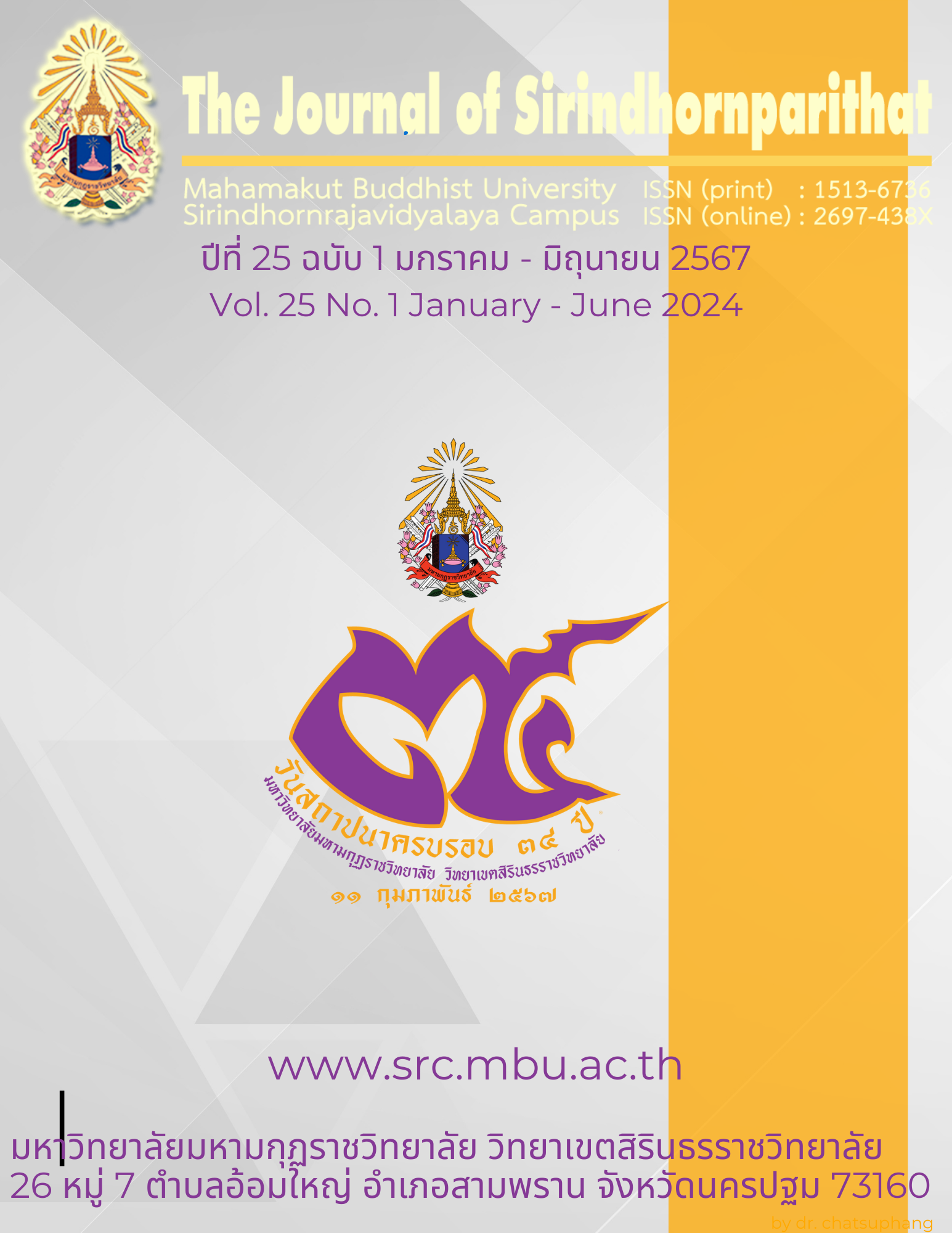A Conceptual Model of Buddhist Dhamma Gīta for Healthy Mind Enhancement
Keywords:
Buddhist, Dhamma Gīta, Healthy Mind, Conceptual ModelAbstract
The paper studies the Buddhist Dhamma Gīta to present a Conceptual Model for Healthy Mind Enhancement to provide the solution for the population with increasing mental health issues especially from the Covid-19 outbreak. The main objective are firstly to study the healthy mind concept using the Buddhist Dhamma Gīta and subsequently, present the conceptual model for healthy mind enhancement. This paper's methodology is qualitative research, which includes a literature review and a field study, and is based on the following objectives.
The research findings emphasize the use of Buddhist Dhamma Gīta, or Dhamma songs, as a means to enhance a healthy mind. A conceptual model is presented, integrating Dhamma Gīta into meditation and spiritual practices within Theravada Buddhism. Dhamma Gīta is found to promote mindfulness, improve focus, and cultivate positive emotions. It offers convenience and accessibility, making it beneficial for individuals with limited time and health constraints. The model includes practices such as mindfulness, stress management, and relaxation exercises, along with social support and increased awareness about mental health. Implementations include online platforms, videos, and audio resources to facilitate easy access. Dhamma Gīta is seen as a powerful tool for enhancing mental well-being, understanding Buddhism, and fostering spiritual growth.
In general, the study results indicate that Dhamma Gīta holds great potential as a valuable resource for individuals on their path to achieving a sound mental state, enlightenment, and relief from suffering. It assists in comprehending Dhamma, encourages mindfulness, fosters virtuous qualities, and supports spiritual development. The conceptual model offers a structure for utilizing Dhamma Gīta to improve mental well-being and gain insights into Buddhist teachings.
References
Mahachulalongkornrajavidyalaya University. (1992). Pali Tipitakas: Mahachula Tepitakam Edition. Bangkok: Mahachulalongkornrajavidyalaya University Press.
Thai Tipitakas. (1996). Mahachulalongkornrajavidyalaya Edition. Bangkok: Mahachulalong kornrajavidyalaya University Press.
Arnaud.Cabanac, Leonid Perlovsky, Marie-Claude Bonniot-Cabanac, Michel Cabanac. (2013). Music and academic performance. Behavioural Brain Research. 256 : 257-260.
Bronkhorst, Johannes. (2021). The Rise of Classical Brahmanism.
Buddhaghosa, Himi. (2010). The Path of Purification: Visuddhimaga/Buddhaghosa Himi. Nyanamoli Himi - Kandy: Buddhist Publication Society.
Cambridge Dictionary. (2023). Cambridge: Cambridge University Press.
Devarajan Sridharan, Daniel J. Levitin, Chris H. Chafe, Jonathan Berger, and Vinod Menon. (2007). Neural Dynamics of Event Segmentation in Music: Converging Evidence for Dissociable Ventral and Dorsal Networks. Neuron. 55(3) : 521-532.
Dobrzyńska, Ewelina & Cesarz, Helelna & Rymaszewska, Joanna & Kiejna, Andrzej. (2006). Music Therapy - History, definitions, and application. Archives of Psychiatry and Psychotherapy. 8(1) : 47-52.
G Desbordes, LT Negi, TWW Pace, BA Wallace. (2012). Effects of mindful-attention and compassion meditation training on amygdala response to emotional stimuli in an ordinary. non-meditative state. Frontiers in human neuroscience.
Greenwood, S., Perrin, A., Duggan, M., Greenwood, S., Perrin, A., & Duggan, M. (2017). Demographics of Social Media Users in 2016.
Helen Herman, Vikram Patel, Christian Kieling, et al. (2022). Time for united action on depression: a Lancet-World Psychiatric Association Commission. The Lancet Commissions. 399(10328) : 957-1022.
Maercker, Andreas & Forstmeier, Simon. (2011). Healthy brain aging: The new concept of motivational reserve, 2011 Psychiatrist. 35(5) : 175-177.
Noa Ronkin. (2011). Early Buddhist Metaphysics: The Making of a Philosophical Tradition.
Phra Pramote Pamojjo. (2007) Ariyasaccāni, p.37
Phra Pramote Pamojjo. (2007) Ariyasaccāni, p.18
Phra Pramote Pamojjo. (2007) Ariyasaccāni, 2007, p.20
Phra Pramote Pamojjo. (2007) Ariyasaccāni, 2007, p.26
Phra Somdet Buddhakosajarn (Phra Brahmagunabhorn P.A. Payutto). (2003) BuddhaDhamma Extended Version. Bangkok, Thailand.
Phra Somdet Buddhakosajarn (Phra Brahmagunabhorn P.A. Payutto). (2003). Dictionary of Bhuddism, 12th Edition.
Phra Somdet Buddhakosajarn (Phra Brahmagunabhorn P.A. Payutto). (1996). The difference between chanting and singing in Follow the Newly Ordained Monks Go to Study Dhamma. (Dhamma Preaching for Nawaka, Batch 1996), (Thai Version).
Robinson, Stewart & Arbez, Gilbert & Birta, Louis & Tolk, Andreas & Wagner, Gerd., (2015). Conceptual Modeling: Definition, Purpose and Benefits, Proceedings of the 2015 Winter Simulation Conference.
Sri Swami Sivananda, Bhagavad Gita, (2000). A Divine Life Society Publication.
T. W. Rhys Davids, William Stede, editors. (1921). The Pali Text Society’s Pali–English dictionary. Chipstead: Pali Text Society.
Thorsen et al. (2013). The predictive value of mental health for long-term sickness absence: the Major Depression Inventory
(MDI) and the Mental Health Inventory (MHI-5) compared. BMC Medical Research Methodology.
World Health Organization. (2017). Depression and Other Common Mental Disorders: Global Health Estimates. Geneva.
Chaiyen Ratnavijarn. (2020). Methods of kusula citta cultivation for treatment of mental disorders. A Dissertation Submitted in Partial Fulfilment of the Requirements for the Degree of Doctor of Philosophy (Buddhist Studies). Graduate School: Mahachulalongkorn rajavidyalaya University, Bangkok.
Koehler, Sarah Nichole and Parrell, Bobbie Rose. (2020). The impact of social media on mental health: A mixed methods research of service providers’ awareness. Master’s thesis, Graduate School, California State University San Bernardino ScholarWorks.

Downloads
Published
Issue
Section
License
Copyright (c) 2024 Mahamakut Buddhist University

This work is licensed under a Creative Commons Attribution-NonCommercial-NoDerivatives 4.0 International License.
บทความที่ได้รับการตีพิมพ์เป็นลิขสิทธิ์ของ มหาวิทยาลัยมหามกุฏราชวิทยาลัย วิทยาเขตสิรินธรราชวิทยาลัย
ข้อความที่ปรากฏในบทความแต่ละเรื่องในวารสารวิชาการเล่มนี้เป็นความคิดเห็นส่วนตัวของผู้เขียนแต่ละท่านไม่เกี่ยวข้องกับหาวิทยาลัยมหามกุฏราชวิทยาลัย วิทยาเขตสิรินธรราชวิทยาลัย และคณาจารย์ท่านอื่นๆในมหาวิทยาลัยฯ แต่อย่างใด ความรับผิดชอบองค์ประกอบทั้งหมดของบทความแต่ละเรื่องเป็นของผู้เขียนแต่ละท่าน หากมีความผิดพลาดใดๆ ผู้เขียนแต่ละท่านจะรับผิดชอบบทความของตนเองแต่ผู้เดียว



